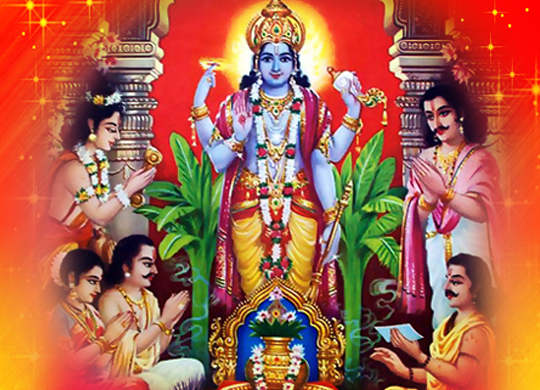For puja Dates and Timings, Please click on the Link Below
Satyanarayana Swamy Vratham:
The Satyanarayana Vrata is a Hindu religious observance. It is a ritual performed by devotees on any major occasion like marriage, house warming ceremony etc. It can also be performed on any day for any reason. It finds first mention in Skanda Purana
The Satyanarayana Puja is usually done on the Full Moon (Purnima) day of every month or any day you wish to do it. It is also done on special occasions and during times of achievements as an offering of gratitude to the Lord Vishnu. In addition, it is said that a devotional performance of this puja will bear children to couples trying to start a family.
The Satyanarayana Puja is a Hindu religious observance. It is a ritual performed by Hindus before/on any major occasion like marriage, house warming ceremony etc. It can also be performed on any day for any reason. The Satyanarayana Puja is unique in that it does not require a Brahmin to perform.
The Satyanarayana Puja is usually done on the Pournami day of every month (full moon day), ekadasi (11th day after full moon or new moon), kartheeka paurnami, vaisakha paurnami, solar eclipse day or on Sankranti except during Ashada masam. It is also done on special occasions and during times of achievements as an offering of gratitude to the Lord. These occasions include marriage, graduation, new job, and the purchase of a new home to name a few. In addition, it is said that a devotional performance of this puja will bear children to couples trying to start a family. Summary of the puja process:
The puja starts by a prayer to Lord Ganesha, to remove all obstacles that may occur as a result of incorrectly performing the puja. This is done by chanting all the names of Lord Ganesha and offering prasad (a food offering, usually consisting of one of Lord Ganesha’s favorite foods – modak, a sugar and coconut mixture, or lhadu) and the showering of flower petals.
Another part of the prayer involves a prayer to the Navagraha’s – the nine important celestial beings in the universe. They consist of Surya (the Sun), Chandra (the moon), Angaaraka/Chevaai (Mars), Budha (Mercury), Guru aka Bruhaspati (Jupiter), Shukra (Venus), Sani (Saturn), Rahu (the head of the Demon snake), and Ketu (the tail of the Demon snake).
The rest of the puja consists of worship to Satyanarayana, an extremely benevolent form of Lord Vishnu. First “panchamritam” is used to clean the place where the deity is placed. After placing the deity in the correct position, Satyanaraya swami is worshipped. Names of Satyanarayana are chanted along with offering of a variety of prasad (including a mixture of milk, honey, ghee/butter, yogurt, sugar) and flower petals.
Another requirement of the puja is that the story of the puja be heard among all those observing and partaking in the pooja. The story involves the origin of the puja, the benefits of it, and the potential mishaps that may occur with the careless performance of the puja.
The prayer concludes with an Aarti, which consists of revolving a small fire-lit-lamp in the vicinity of an image of the Lord. After the puja is over, participants and observers of the pooja are required to ingest in the prasad that was offered and blessed by the Lord.
It is told that Satyanarayan Katha is in REVA volume of Skanda Purana. But this volume is devoted to pilgrimages on the valley of river REVA. In Satyanarayana there is no Reva river. In original Skanda Purana there is nothing like Satyanarayana. Recent Skanda Puranas added it with clear note of its new addition in Skanda. Puja vidhanam:
The Satyanarayan Puja is performed in reverence to the Narayan form of Lord Vishnu. The Lord in this form is considered an embodiment of truth. This puja is conducted to ensure abundance in ones life. Many people carry out this puja immediately after or along with an auspicious occasion like a marriage or moving into a new house or any other success in life. It is believed the ceremony originated in Bengal as Satya Pir and was later adapted into Satyanarayan puja.

